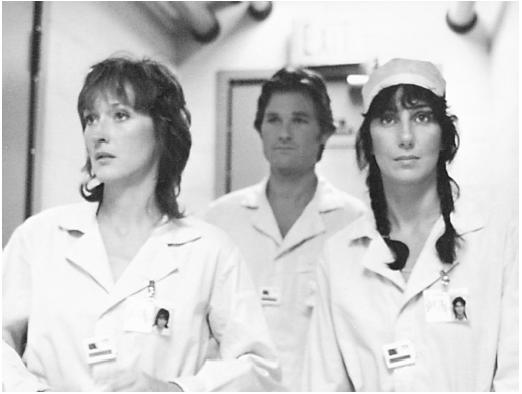Silkwood
Silkwood has so many unexpected charms: that Karen Silkwood is not a saint, but a basically decent and courageous woman, and a feckless and sometimes bratty woman; Drew leaving, then coming back to tell her, “I love two people,” then going anyway. Karen and Drew’s “wait, why are we still talking about this?” discussion of Dolly’s sexuality, quite progressive for ’70s characters in an early-’80s film (and Diana “Christina Crawford” Scarwid as Dolly’s draggy-Dixie girlfriend Angela). E. Katherine Kerr packing a single word, “casserole,” with exhaustion, irritation, and nausea.
Nor did I expect, then, that the movie would feel unsatisfying to me in the end. Roger Ebert’s review notes that director Mike Nichols is “not telling the story of a conspiracy, he’s telling the story of a human life,” which Ebert considers a positive, and I agree; so often on film, the working-class hero only has that one dimension. The trouble is that we only know Karen Silkwood’s name, and the film likely only got made, because she tried to blow the whistle on unsafe practices at the plant, and as the story begins to become about that and not about her, the characters recede behind the formula.
Then it ends, and I respect several of the choices made for the ending — the other employees watching the crushed car coming through town; Streep’s unaccompanied voice in lullaby mode — but the slowed-down scene from only a few minutes before rang cheap, and Karen’s death is cast as an assassination of sorts. And it may have been, but I’d related to Karen thus far as a real person, and the final sequence gives us a cardboard angel instead. I wanted to mourn the woman, not the story.
The movie is good — good pacing, good texture, fantastic performances (Cher is strained at first, but settles into Dolly after a time) — but I think it didn’t know how to transition into the hero’s-journey biopic it thought it needed to become, and it didn’t need to do that at all in the end.
Tags: Christina Crawford Diana Scarwid E. Katherine Kerr Karen Silkwood Kurt Russell Meryl Streep Mike Nichols movies Roger Ebert







I don’t know how the film could have avoided becoming, at some point and at least to some degree, a whistleblower movie. I mean, that’s what it IS. But I thought the script achieved a nice balance. Anyway, none of this matters: the film is awesome solely due to its extremely high Shirtless Kurt Russell quotient.
Well, but it isn’t, that’s the issue. 1) It’s not called “Shenanigans At Kerr-McGee.” It’s about her. She is in fact a whistle-blower, but she’s a bunch of other things, too, and the movie seems far more interested in those other things for about 90 minutes.
I don’t dislike whistle-blower movies, per se, and if Silkwood had gone that route, that would have been fine. That aspect of it seemed like an afterthought that didn’t get foregrounded until like five minutes before she gets killed, which ultimately didn’t work for me.
Since I was a kid, I’ve had a decontamination shower scene floating around in my head. I never knew what movie or show it was from. Once you posted this review, and I saw the pic, I realized it must be from Silkwood. I looked it up on YouTube, and it’s even more disturbing than I remember. Now I need to watch the whole movie and put it in context.
I see where you’re coming from, and I agree that this film doesn’t (or at least shouldn’t) belong to the same genre as The Insider or The China Syndrome. But I feel that the whistleblower elements in Silkwood were introduced and explored in a really natural way; that’s what dominated the end of her life, and if the movie’s about her, well, that’s what we’re gonna see. Like you said, the whistleblowing is the reason we know her name.
I was pleasantly surprised at how engaging this movie was and naturalistic. Great performances, careful direction, interesting story – everything. But the best part is still Kurt Russell clad only in low-hanging jeans. Damn, he looked good!
Jas, that scene makes me want to cry & puke & punch someone in the face really hard and then cry some more. I can see why it haunts you. This movie had me on the edge of my seat every minute.
Sars, I love your reviews. I get too caught up in the story to really notice the construction & such, so your perspective is always thought-provoking. Thank you.
@Jas – I haven’t watched this movie in years (20+), but that decontamination scene is always my first thought whenever I see or hear anything about this movie. Just shattering stuff.
Oh man…watched that movie in my adolescent years (I think it was in heavy rotation on HBO in the mid-80s) and have never forgotten it. That shower scene has been burned on my brain. I think I need to re-watch it now.
@Jas: I agree; even (or especially?) in context, the decontamination scene is brutal. Its combination of fearful rage and this weird blame-filled, scapegoating kind of feeling from the techs horrified me. I’ve never forgotten it either.